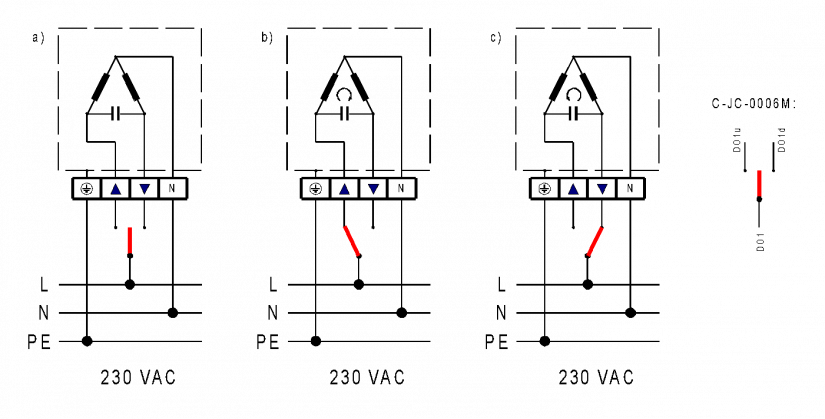The motors for drives of blinds, awnings and similar devices are typically AC asynchronous motors with reverse switching of power supply coil (directly and via the capacitor), with a typical power consumption from 60 to 150 VA. The three-point controlled actuators used for the control of e.g. heating systems have motors with identical design. They are controlled in the same way and they can also be connected in the same way as the asynchronous motors for blinds.
The following figure shows the principle of control of the rotation direction in 1ph asynchronous motor for blinds:

a) The motor is inactive, both outputs (e.g. the DO1u and DO1d outputs in the C-JC-0006M module) are open.
b) The motor is turning up, the DO1u output is switched to the phase of the 230VAC supply wire.
c) The motor is turning down, the DO1d output is switched to the phase of the 230 VAC supply wire.
Switching can be carried out by any Foxtrot system relay outputs, but in order to rule out switching both outputs (directions) at the same time, it is preferable to use relays where switching contacts are connected with an interlocking switch (see the Chapter Control of asynchronnous motors for external venetian blinds and awnings).
 It is absolutely necessary to eliminate in these drives a simultaneous connection of input terminals for both directions - it is very likely to damage the motor.
It is absolutely necessary to eliminate in these drives a simultaneous connection of input terminals for both directions - it is very likely to damage the motor.
 Only one motor can be connected to one relay output of the system, unless it is specifically permitted by the manufacturer of the blinds (their drives).
Only one motor can be connected to one relay output of the system, unless it is specifically permitted by the manufacturer of the blinds (their drives).
The control logic itself (end positions, running time, turning blinds) must be dealt with in the application program according to specific motors and their controlled shading elements, e.g. via the ready-to-use function blocks in the Mosaic environment.
It is always necessary to ensure that there is no simultaneous switching of both outputs (up and down), and if the direction of movement is rapidly switched (e.g. from the way up to the way down), at least 300 ms pause must be guaranteed (as specified by the motor manufacturer) to avoid damaging both the motor and the complete relay system output.
For interior venetian blinds and roller blinds are also used smaller DC motors (12 VDC or 24 VDC), in which the direction of rotation is reversed by changing the polarity of the supply voltage (see. Chapter Control of asynchronous motors for blinds and awnings).
In outdoor awnings it is advisable to deal with automatic closing in relation to the wind speed, for whichthe T114 anemometer can be used, as well as the GIOM3000 weather station or similar sensors. It is also possible to use information from the rain gauge and other sensors in the Foxtrot system.
The venetian blinds can also be controlled with regard to the speed of wind, like awnings, and information from glass break detectors can also be used for their control (e.g. if glass is broken during a hailstorm, the venetian blinds are closed to mitigate possible damage in the house interior, in spite of the risk of the blinds being damaged).
Both outdoor and indoor illumination intensity sensors can also be used for the control of blinds in order to maintain the desired level of interior illumination.
 English
English